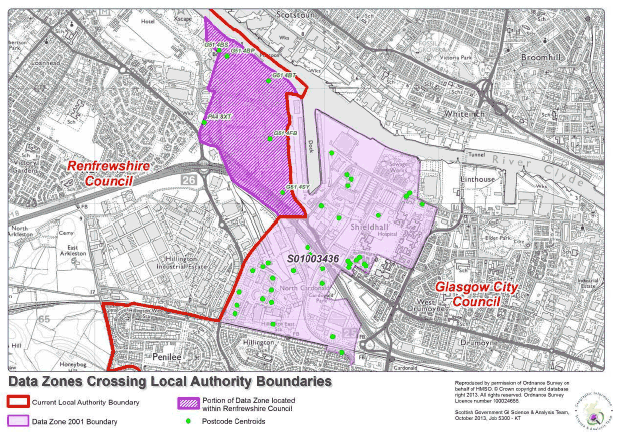Consultation regarding the redraw of Data Zones
This consultation contains proposals for the redraw of Data Zones
5. Changes to Higher Level Geographies
5.1. Problems can occur when the boundaries of other geographies change and common boundaries between Data Zones and higher level geographies become eroded. This means that, where in the past it would have been possible to aggregate Data Zones and get an exact match for a higher level geography, only best-fit aggregations are now possible. This also raises a potential disclosure issue where it may be possible to infer information about the very small gaps that exist between aggregations of Data Zone statistics and statistics produced using the exact boundaries of higher level geographies. These gaps are often referred to as slivers.
5.2. Local Authority boundaries rarely change, but can cause disclosure issues when they do. In figure 1.3 below, the Data Zone boundary exactly followed the Local Authority boundary in 2001. Since then, there have been some developments in the area and the Local Authority boundaries have been redrawn to accommodate this, while the Data Zone boundaries remain unchanged.
Fig 1.3: Showing Data Zone S01003436 which crosses the Local Authority boundary between Renfrewshire and Glasgow City

5.3. In this case, the shaded area towards the north west of the Data Zone should be allocated to Renfrewshire council, and will be if statistics are calculated on the basis of postcodes, but fall within Data Zone S01003436 and will be allocated to Glasgow City council if Data Zones are used to aggregate to Local Authority boundaries.
5.4. If a set of statistics were available at both Data Zone level and at Local Authority level, it would be possible to deduce information about the gaps between these areas. This raises a disclosure risk and in order to prevent this, analysts need to apply disclosure control to their statistics or withhold certain figures. The type of disclosure control applied is likely to be rounding or probabilistic rounding. This creates additional work for the analyst and reduces the utility of the statistics. Further information on statistical disclosure control can be found in this paper:
Contact
Email: Victoria Kinnear - Lachhab
There is a problem
Thanks for your feedback